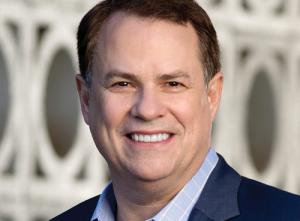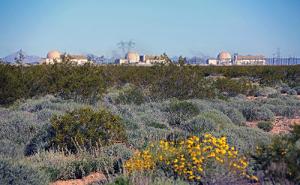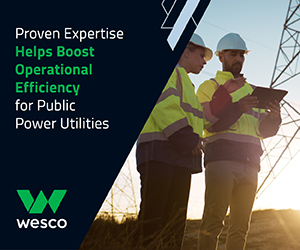Arizona Public Service
Jeff Guldner is the CEO of Arizona Public Service. Chris Rogers is West Market Leader, Energy Providers Practice at Guidehouse.
Arizona Public Service is the largest energy provider in the iconic Grand Canyon State, serving some 2.7 million customers across a large area, and with six thousand employees. The utility is committed to providing one hundred percent clean, carbon-free energy to customers by 2050.

Heading up that ambitious endeavor is APS CEO Jeff Guldner, who holds numerous titles, not only at APS, but at parent company Pinnacle West Capital, where he is also CEO and Chairman of the Board. Having Guldner at the helm of APS as it takes this journey is indeed providential as achieving grand decarbonization goals isn't easy.
Public Utilities Fortnightly's Joseph Paparello and Guidehouse's Chris Rogers discussed with Guldner how APS plans to achieve its clean-energy goals and much more. Enjoy this conversation around the challenges and opportunities faced by APS.
PUF's Joe Paparello: Talk about how APS served customers and met demand during a record breaking 2022 monsoon season in Arizona. I'm not sure many know Arizona experiences a monsoon season each year.
Jeff Guldner: We don't have big earthquakes, and we don't have hurricanes. But one of the phenomena we do have is monsoon storms, and that's generally a good thing because they bring moisture into the desert.
 Jeff Guldner: We don’t know all the technical answers of how exactly we’re going to get to zero by 2050, but part of the reason to set that goal is because it signals vendors, suppliers, supply chain, and partners that we need to find technology solutions that will help get us to that point.
Jeff Guldner: We don’t know all the technical answers of how exactly we’re going to get to zero by 2050, but part of the reason to set that goal is because it signals vendors, suppliers, supply chain, and partners that we need to find technology solutions that will help get us to that point.
But in that monsoon season, you can see microbursts that have north of a hundred mile an hour winds that will hit a small part of the territory. The good news is that this summer we had a robust monsoon and got a fair amount of moisture. It helped our wildfire risk.
We were out of danger from a wildfire standpoint early in the summer. But from an impact to customers and the grid, we typically lose about two hundred ninety poles a year to the monsoon. We lost more than eight hundred this time, plus some transmission towers. If those poles were arranged end to end on the ground, they would measure seven miles long.
This is where we focus on building a resilient electrical system. Our crews responded during the storms, replaced poles, made repairs, and connected power for customers quickly. After each monsoon, we take note of our lessons learned and ask ourselves, "What improvements can we make to strengthen our system?"
Our stopper pole program is a great example of this. Through the program, we replace the wood poles with sturdier materials. If we have a long line of wood poles, we'll put stopper poles as a prevention measure to mitigate damage to an entire distribution line.
 APS Palo Verde Generating Station.
APS Palo Verde Generating Station.
Our weather can pose some challenges, but our teams work hard to plan a strong system that keeps the lights on for customers.
We'll take the moisture. We like to see a good monsoon, but as an industry, we're focused on the concept of resilience. We want to make sure we can weather these storms and we're designing the system to survive those events.
PUF: We were just at an event in D.C., and supply chain challenges with wood utility poles were mentioned. Is that something you have experienced?
Jeff Guldner: Yes. We've seen it a little more in the transformer space. We were able to work through them, as we have a good supply chain team.
I hope as the economy continues to improve so that we're able to manage some of the supply chain constraints better. In a high growth environment, supply chain issues don't just affect us. We see our customers adding new manufacturing facilities in Arizona.
They're having challenges in getting some basic materials through their supply chain. It's a national issue that we want to make sure we are appropriately focused on at all levels, both private industry and up at the government.
Guidehouse's Chris Rogers: Jeff, California had some energy emergencies last summer. How was APS able to reliably serve throughout that heat wave that almost played a role in blackouts in California?
Jeff Guldner: The summers are getting increasingly challenging because of a combination of things. As an industry, we're seeing a lot of the coal retire off the system. In California, there've been a fair amount of power plant retirements and we are all interconnected.
Being part of the Western Electric Coordinating Council means we all support each other, and we were able to help that situation. I'll talk a little about how we meet our customer peak demand.
One of the real values of that system interconnection is we peaked earlier in the summer, in the July timeframe, and California tends to peak later in the September timeframe. So, there was a period when we were hitting that peak, where we were buying a lot of energy from the Pacific Northwest through California.
Then vice versa, when we were having relatively moderate weather during that California heat wave, after serving our customers, we sold excess power to our neighbors to help the California System Operator.
Our resource planning team has done a phenomenal job of both making sure our power plants are in the mix, but also looking at where we can get a diverse mix of resources. We forecast customer needs and consider temperature trends, along with planning a backup supply of power for our summer season.
But the real magic that helps us get through a summer like this is excellent plant operations. We call it, equivalent availability factor. Our power plants were available about ninety-five percent of the time.
Palo Verde delivered over a hundred percent capacity factor. It performed well when we needed it most �" during Arizona's hot summer season. It was cranking a few more megawatts out and ran straight through the summer.
If you've got that good plant performance, transmission energized, and a lot of diversity in the resource mix, the final piece of the puzzle is how we then engage our customers.
Customer engagement will be increasingly one of the most important resources we as an industry have. We're developing programs and finding meaningful ways to incentivize customers to provide flexible demand response on those hot days.
To give you two examples, we've had time-of-use rates here in Arizona since the 1970s. Last summer, our time-of-use was generally three p.m. to eight p.m. What you would see if you're looking at the resource chart, the load and resource graph, at three p.m., there'd be about a hundred megawatt drop in demand.
That's not from calling a demand response event. That's the effect of rate design with customers having programmed thermostats such that it will climb up a few degrees during peak period. So, we see about a hundred megawatts of capacity. That's equivalent to a peaking power plant. That comes from basic residential customer rate design.
Then we've got about seventy-two thousand customers enrolled in our smart thermostat program, APS Cool Rewards. That's more sophisticated. On a day we're going to partner with customers, we'll work with their thermostat manufacturers to pre-cool participants' homes before the event initiates. This helps keep customers comfortable when the thermostat increases a few degrees during the event.
Today, our Cool Rewards network can provide more than one hundred megawatts of capacity. Essentially, we're getting two peaking power plants from customer response from either rate design or a program like Cool Rewards.
With Cool Rewards, customers can control their thermostats and can make adjustments if they want to. By growing participation in the program, we can better understand the impact that can be made.
PUF: I understand your service territory is growing and customer usage is increasing. There are more EVs and other demands on the system. Explain how APS plans to meet the historic growth in Arizona.
Jeff Guldner: We are seeing a transformation in the economy of the state. If you look back to the last recession in the 2007 timeframe, we were in a construction-based economy.
Fast forward to today, we have an economy centered around advanced manufacturing, electric vehicles, and the Taiwan semiconductor.
That's all happening in our footprint. It creates opportunity because that helps spread fixed costs around to a bigger system or more kilowatt hour consumption. But it makes it challenging during that summer peak.
We are working closely with customers, whether they're data centers or manufacturers looking at microgrid opportunities. What we're seeing is about a hundred hour a year problem. There're about one hundred hours out of the eight thousand seven hundred sixty hours.
How do you do that in a way when you don't want to build a big central station power plant? For that problem, are there opportunities where we can partner with customers to use backup generation that's already there?
We're looking at maximizing production that we can get out of our existing power plants and continuing to scale customer side opportunities. But the next leg of this in terms of beating that growth, and we'll do a lot of it with solar and batteries, is we're putting batteries at every one of our solar facilities. But we want to maximize use of infrastructure and see how far we can go with that combination of batteries and solar.
Often, we don't have a lot of wind during those one hundred hours. But can we work with customers on microgrids? We've got a great one at Marine Corps Air Station in Yuma. There's more opportunity ahead with that.
We're also looking at how we can work with customers who have flexible loads and might be able to ask, "Can you essentially drop production?" If you're making hydrogen or something like that, there may be ways you can turn off that electrolyzer over peak and fire it back up again and we can get some interruptible load, to again, maximize system efficiency.
Chris Rogers: Jeff, what will a secure, clean, and balanced energy supply look like for Arizona as you look out in the future to the 2050 goals?
Jeff Guldner: It is significant why we picked 2050 as our goal to be a zero-carbon energy system. One of the key things is continuing to operate Palo Verde Generating Station, which is the largest nuclear power plant in the United States.
Continuing to operate Palo Verde is going to require a second license extension to get it past the mid-2040s. But that baseload solid, reliable power plant is going to be critical to make sure grid stability is there.
We will continue to see technology evolution, so you'll start seeing natural gas power plants replaced with the hydrogen, either hydrogen power plants or clean fuel process. Maybe it's carbon capture and sequestration.
We don't know all the technical answers of how exactly we're going to get to zero by 2050, but part of the reason to set that goal is because it signals vendors, suppliers, supply chain, and partners that we need to find technology solutions that will help get us to that point.
The other thing we'll see is there will be a massive change in how consumers expect to use electricity and the value of things like smart water heaters, and home energy management systems.
The potential for distributed storage to provide a lot of benefits in helping us manage through those peak periods is going to be a key. We're going to see a lot more batteries on the system.
I expect there will be battery technology advances that will move us toward longer duration and different battery chemistries that will be able to give us a diverse mix. We know how to run lithium-ion batteries, but it will be beneficial when we see additional technologies.
The biggest challenge we have as an industry is the concept of long duration storage. Hydrogen may be an opportunity, but our challenge in the desert southwest is we have tremendous solar energy in April with low demand.
But typically, when it's sunny, we're producing a lot of solar energy. The big challenge we have is not shifting the energy from noon to eight p.m. The big challenge is how do I take energy in April and then use it in July? That's where research needs to focus on long duration storage opportunities.
PUF: As utilities transition to greener resources and navigate a tighter energy market in the west, industry resource planning is becoming more complex. What are some innovative solutions or plans APS is deploying to continue to keep the lights on?
Jeff Guldner: Important context with that is there is a capital-intensive shift that's happening now in both building new resources but also hardening the grid.
As electrification is coming, that's going to require us to make additional investments in the transmission and distribution systems to support additional consumption while at the same time, we're retiring existing assets, the coal plants, and we're having to construct replacement assets.
We've got to do all that while managing customer affordability. A lot of the focus is on customer facing programs that can give opportunities for customers to save money and still bring resource value.
You want to engage all customers, the commercial, industrial, and residential customers in this transition to a clean-energy future. But on managing the system, you want to look at further market development in the west.
We depend heavily on the Pacific Northwest to help bring us summer supply and we provide energy back to them in the winter when they're typically peaking. Continuing to strengthen the energy ties around the region gives us a lot of resource diversity without having to build new resources.
Then optimizing our Arizona asset mix. It's solar and storage, how to deploy effectively additional solar energy, and pair it up with storage so we can use that energy when we need it on peak and thereby maximize our assets.
But it is going to take a combination of all of that, in addition to better visibility into the distribution system, upgrades, and investments in the grid to be able to meet the needs of our customers as we see continued electrification and more opportunities to decarbonize here and around the region.
PUF: Jeff, what other challenges and opportunities do you see coming for APS in the next five to ten years?
Jeff Guldner: It is this challenge of the amount of growth. We're seeing scale orders of magnitude, different scales of data centers and advanced manufacturing, and a variety of industries coming onto the grid.
That requires a different thought process about how you're going to meet those demands. We're going to have to get creative in how we use every resource that's on the system so we can manage customer affordability while still moving forward.
The R&D side too, is where it gets tricky in trying to understand which technology advances we are likely to see. There will be a limit to how much you want to depend on batteries to manage your system. We can scale those well around the west, but when you look at individual system risk, you're going to have a limit of how much battery you can reliably operate on the grid.
We're thinking through, what does that mean? If I don't have an unlimited ability to scale batteries up, how am I going to figure out the technology solutions that will allow me to continue to meet growing electric demand on peak and still maximize the value of the system?
If we're building stuff that only gets used a hundred hours a year, that's tough. You want to figure out, how to optimize it, use flexible demand, what's the consumer behavior, and how are the behavioral economics going to look in the future?
That's causing people to push outside their traditional resource planning comfort zones. But it is a great opportunity, and we focus our culture at APS around a growth mindset.
We anchor everything around what we call, the APS Promise. This means that as stewards of Arizona, we do what's right for the people and prosperity of our state. We're helping drive economic development, continued growth, and then we'll try to figure out, how do we constructively look at meeting that demand?
But every state around the region is going to be a bit different in terms of what challenges they're seeing and the solutions that are going to be needed to address those challenges. In Arizona, we have opportunities to use innovative thinking and develop solutions to secure a resilient, affordable and clean-energy future for our customers.
Lead image: APS Solar Plant.



